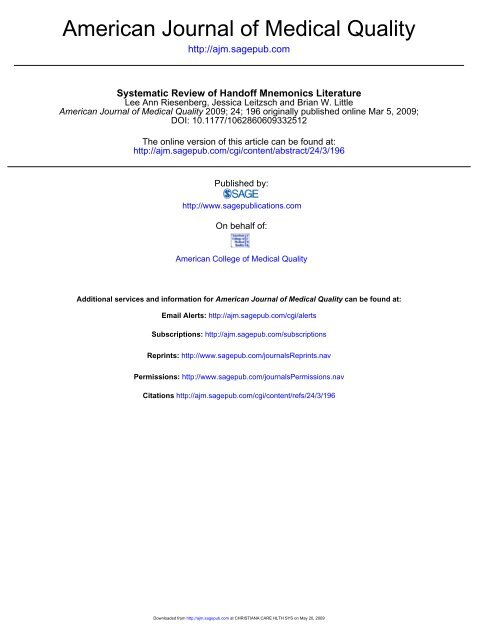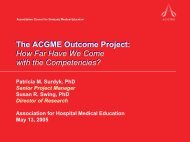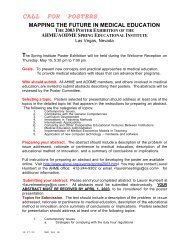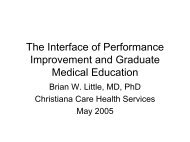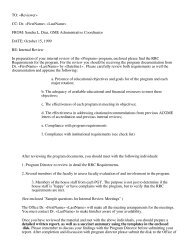Handoff Mnemonic Systematic Review.pdf - Association for Hospital ...
Handoff Mnemonic Systematic Review.pdf - Association for Hospital ...
Handoff Mnemonic Systematic Review.pdf - Association for Hospital ...
Create successful ePaper yourself
Turn your PDF publications into a flip-book with our unique Google optimized e-Paper software.
American Journal of Medical Quality<br />
http://ajm.sagepub.com<br />
<strong>Systematic</strong> <strong>Review</strong> of <strong>Handoff</strong> <strong>Mnemonic</strong>s Literature<br />
Lee Ann Riesenberg, Jessica Leitzsch and Brian W. Little<br />
American Journal of Medical Quality 2009; 24; 196 originally published online Mar 5, 2009;<br />
DOI: 10.1177/1062860609332512<br />
The online version of this article can be found at:<br />
http://ajm.sagepub.com/cgi/content/abstract/24/3/196<br />
Published by:<br />
http://www.sagepublications.com<br />
On behalf of:<br />
American College of Medical Quality<br />
Additional services and in<strong>for</strong>mation <strong>for</strong> American Journal of Medical Quality can be found at:<br />
Email Alerts: http://ajm.sagepub.com/cgi/alerts<br />
Subscriptions: http://ajm.sagepub.com/subscriptions<br />
Reprints: http://www.sagepub.com/journalsReprints.nav<br />
Permissions: http://www.sagepub.com/journalsPermissions.nav<br />
Citations http://ajm.sagepub.com/cgi/content/refs/24/3/196<br />
Downloaded from http://ajm.sagepub.com at CHRISTIANA CARE HLTH SYS on May 20, 2009
<strong>Systematic</strong> <strong>Review</strong><br />
of <strong>Handoff</strong> <strong>Mnemonic</strong>s Literature<br />
Lee Ann Riesenberg, PhD, RN<br />
Jessica Leitzsch, BS<br />
Brian W. Little, MD, PhD<br />
A systematic review of published English-language<br />
articles on handoffs is conducted (1987 to June 4,<br />
2008). Forty-six articles describing 24 handoff mnemonics<br />
are identified by trained reviewers. The<br />
majority (82.6%) have been published in the last 3<br />
years (2006-2008), and SBAR (Situation, Background,<br />
Assessment, Recommendation) is the most frequently<br />
cited mnemonic (69.6%). Of 7 handoff research articles,<br />
only 4 study mnemonics. All 4 of these studies<br />
have relatively small sample sizes (10-100) and lack<br />
validated instruments. Only 1 study has obtained<br />
IRB approval. Scientifically rigorous research studies<br />
are needed to assess the effectiveness of handoff<br />
mnemonics. These should be published in the peerreviewed<br />
literature using the Standards <strong>for</strong> QUality<br />
Improvement Reporting Excellence (SQUIRE) guidelines.<br />
(Am J Med Qual 2009;24:196-204)<br />
Keywords: handoff; handoffs; mnemonic; sign-out<br />
Effective communication is central to safe and effective<br />
patient care. <strong>Handoff</strong>s or transfers of patient<br />
care from one health care provider to another are<br />
known to be vulnerable to communication failures. 1-4<br />
As defined by the Joint Commission, handoff communication<br />
“refers to a real-time process of passing<br />
patient/client/resident-specific in<strong>for</strong>mation from one<br />
caregiver to another or from one team of caregivers<br />
AUTHORS’ NOTE: Dr Riesenberg is with Academic Affairs,<br />
Christiana Care Health System, Newark, Delaware, and<br />
the Jefferson School of Population Health, Philadelphia,<br />
Pennsylvania. Ms Leitzsch is with Academic Affairs, Christiana<br />
Care Health System, Newark, Delaware. Dr Little is with<br />
Academic Affairs, Christiana Care Health System, Newark,<br />
Delaware, and Jefferson Medical College, Philadelphia,<br />
Pennsylvania. The authors have no conflicts of interest to disclose<br />
with regard to this article. Corresponding author: Lee Ann<br />
Riesenberg, PhD, RN, Academic Affairs, Christiana Care Health<br />
System, 4755 Ogletown-Stanton Road, Suite 2A00, Newark, DE<br />
19718 (e-mail: Lriesenberg@christianacare.org).<br />
American Journal of Medical Quality, Vol. 24, No. 3, May/June 2009<br />
DOI: 10.1177/1062860609332512<br />
Copyright © 2009 by the American College of Medical Quality<br />
to another <strong>for</strong> the purpose of ensuring the continuity<br />
and safety of the patient/client/resident’s care.” 5<br />
The Joint Commission has reviewed data from<br />
4977 sentinel events that occurred between 1995<br />
and March 31, 2008. 6 In organizations accredited<br />
by the Joint Commission, communication problems<br />
have been identified as one of the contributing<br />
causes in more than 60% of the sentinel events<br />
reviewed. As a result, the Joint Commission created<br />
a new National Patient Safety Goal in 2006: 2E<br />
“Implement a standardized approach to ‘hand off’<br />
communications, including an opportunity to ask<br />
and respond to questions.” 7 This goal has remained<br />
unchanged and was repeated in 2007 8 and 2008. 9<br />
In 2005, the average length of stay <strong>for</strong> all<br />
hospitalized patients was 4.8 days. 10 Assuming that<br />
patient care transfers occur between physicians at<br />
least twice per day and between nurses at least 3<br />
times per day, the average patient will be handed off<br />
a minimum of 24 times per admission. This<br />
represents 24 opportunities <strong>for</strong> inadequate<br />
communication, each of which could result in reduced<br />
patient safety and increased medical errors.<br />
<strong>Mnemonic</strong>s are commonly used to enhance<br />
memory. In the case of handoffs, mnemonics may<br />
increase memory of important steps and provide a<br />
structured process to follow. Our experiences lead<br />
us to believe that many hospitals have responded<br />
to the Joint Commission handoff requirement by<br />
adding a mnemonic to their handoff protocol. The<br />
purpose of the current study was to identify all<br />
handoff mnemonics, describe their use, and<br />
summarize outcomes data from studies using these<br />
mnemonics.<br />
METHODS<br />
We conducted a thorough and systematic literature<br />
search of English-language articles published on<br />
handoffs using Ovid MEDLINE, CINAHL, and<br />
HealthSTAR (1987 to June 4, 2008), followed by<br />
196<br />
Downloaded from http://ajm.sagepub.com at CHRISTIANA CARE HLTH SYS on May 20, 2009
AMERICAN JOURNAL OF MEDICAL QUALITY <strong>Review</strong> of <strong>Handoff</strong> <strong>Mnemonic</strong>s Literature 197<br />
reference section review of all included articles.<br />
The search terms used were (hand-off$ OR handoff$<br />
OR signout$ OR sign out$ OR sign-out$ OR<br />
handover$ OR hand-over$ OR signover$ OR signover$).<br />
A total of 2590 articles were identified. All<br />
titles were reviewed <strong>for</strong> possible inclusion, and 401<br />
articles were obtained <strong>for</strong> further review. Trained<br />
reviewers deemed only 46 articles to meet the<br />
inclusion criteria of focusing on handoffs and<br />
including a handoff mnemonic. Two reviewers (LR<br />
and JL) independently abstracted data.<br />
RESULTS<br />
25<br />
20<br />
15<br />
10<br />
5<br />
0<br />
1 1 1<br />
2 3<br />
1987 2002 2003 2004 2005 2006 2007 2008<br />
Figure 1. Year of publication of 46 English-language<br />
articles focused on health care handoffs, including<br />
a handoff mnemonic, 1987 to June 2008.<br />
22<br />
14<br />
2<br />
Forty-six articles that focused on health care<br />
handoffs yielded 24 handoff mnemonics, with<br />
SBAR (Situation, Background, Assessment,<br />
Recommendation) cited most frequently (Table 1).<br />
Thirty-eight articles (82.6%) were published<br />
between 2006 and 2008 (Figure 1).<br />
Thirty-nine articles presented anecdotal<br />
data, 11,14,19-22,24,26-33,36,41,44,47,50-52,55-56 with 15 of these<br />
providing a patient vignette 18,23,33 or case study<br />
example 12,17,25,35,37-38,42,45-46,48-49,53 depicting the use of<br />
the mnemonic, and 1 of those providing a brief<br />
literature review. 12 There were 7 research studies<br />
of handoffs, 15,40,54 with only 4 of these actually<br />
studying a mnemonic 13,16,39,43 (Table 2).<br />
DISCUSSION<br />
We identified 46 articles describing handoff<br />
mnemonics. Thirty-two articles (69.6%) included<br />
SBAR (Situation, Background, Assessment,<br />
Recommendation). The majority (82.6%) of articles<br />
were published in recent years, which is not<br />
surprising given that the Joint Commission’s<br />
National Patient Safety Goal on handoffs was first<br />
issued in 2006. What is surprising is the lack of<br />
high-quality outcomes studies.<br />
Only 4 of 46 (8.7%) reviewed articles collected<br />
data on handoff mnemonics. These had relatively<br />
small sample sizes (10-100) and failed to use<br />
validated instruments or to conduct validation of<br />
the instruments used. One study used self-reported<br />
familiarity with 2 mnemonics. 13 Haig and<br />
colleagues 39 assessed knowledge of SBAR using a<br />
telephone survey of 10 nurses prior to their<br />
intervention. The authors reported achieving 96%<br />
use of SBAR post intervention but did not provide<br />
details on how this was measured.<br />
Horwitz and colleagues 43 demonstrated a<br />
statistically significant increase (P < .001) in<br />
perceived com<strong>for</strong>t with providing sign-out after a<br />
1-hour educational intervention with medical<br />
students and residents. Their intervention appears<br />
to be well designed, including a systematic<br />
development process. The educational intervention<br />
included discussion, modeling, and real-time<br />
practice, with feedback and evaluation <strong>for</strong> all<br />
learners. This was the only study reporting<br />
institutional review board (IRB) approval. However,<br />
the evaluation instrument appears to be modeled<br />
after the traditional course satisfaction <strong>for</strong>m, with<br />
some items added about attitudes toward and<br />
com<strong>for</strong>t with sign-out. Although this is standard<br />
educational practice, it is not an ideal research<br />
practice, where use of a validated instrument or<br />
some attempt at validation is at least encouraged.<br />
In the only study that examined practice<br />
behavior, there was a decrement in the accuracy of<br />
recall of handover in<strong>for</strong>mation when a mnemonic<br />
(DeMIST) was used. 16 Accuracy of recall was higher<br />
(56.6%) without the mnemonic than with the<br />
mnemonic (49.2%). The authors are to be<br />
commended <strong>for</strong> the assessment of practice; however,<br />
this study has several shortcomings. The sample<br />
was quite small: 18 observed handovers without<br />
the mnemonic and 10 observed using DeMIST. The<br />
authors noted the small sample and explained that<br />
this sample size was used to obtain initial data<br />
without delaying patient care in busy emergency<br />
departments (EDs). The authors also acknowledged<br />
that they did not control <strong>for</strong> staff seniority or<br />
experience. The ambulance crews simply agreed to<br />
structure their handover using the mnemonic<br />
DeMIST. The authors did not report providing<br />
training or practice time using the new handover<br />
Downloaded from http://ajm.sagepub.com at CHRISTIANA CARE HLTH SYS on May 20, 2009
198 Riesenberg et al AMERICAN JOURNAL OF MEDICAL QUALITY<br />
Table 1<br />
<strong>Handoff</strong> <strong>Mnemonic</strong>s Identified in the English-Language<br />
Literature, Including Type of Staff Reported Using the <strong>Mnemonic</strong>, 1987 to June 2008<br />
<strong>Mnemonic</strong> Disciplines or Departments Description<br />
AIDET 11<br />
ANTICipate 12<br />
ASHICE 13<br />
CUBAN 14,15<br />
DeMIST 16<br />
GRRRR 17<br />
HANDOFFS 18<br />
I PASS the<br />
BATON 19,20<br />
Perioperative staff, including<br />
nurses, anesthesiologists,<br />
physicians, and surgical<br />
technologists<br />
Physicians, residents<br />
Ambulance/emergency<br />
department<br />
Emergency department nurses,<br />
nurses, perioperative staff<br />
Ambulance/emergency<br />
department<br />
Nurses, physicians<br />
Physicians, residents<br />
General nurses, perioperative<br />
nurses, physicians<br />
A<br />
I<br />
D<br />
E<br />
T<br />
A<br />
N<br />
T<br />
I<br />
C<br />
A<br />
S<br />
H<br />
I<br />
C<br />
E<br />
C<br />
U<br />
B<br />
A<br />
N<br />
De<br />
M<br />
I<br />
S<br />
T<br />
G<br />
R<br />
R<br />
R<br />
R<br />
H<br />
A<br />
N<br />
D<br />
O<br />
F<br />
F<br />
S<br />
I<br />
P<br />
A<br />
S<br />
S<br />
B<br />
A<br />
T<br />
O<br />
N<br />
Acknowledge the patient<br />
Introduce yourself<br />
Duration of the procedure<br />
Explanation of process and what happens next<br />
Thank you <strong>for</strong> choosing our hospital (note: handoff done at bedside)<br />
Administrative data<br />
New in<strong>for</strong>mation (clinical update)<br />
Tasks (what needs to be done)<br />
Illness<br />
Contingency planning/code status<br />
Age<br />
Sex<br />
History<br />
Injuries<br />
Condition<br />
Expected time of arrival<br />
Confidential<br />
Uninterrupted<br />
Brief<br />
Accurate<br />
Named personnel<br />
Patient demographics<br />
Mechanism of injury<br />
Injuries sustained<br />
Symptoms and signs<br />
Treatments given<br />
Greeting<br />
Respectful listening<br />
<strong>Review</strong><br />
Recommend or request more in<strong>for</strong>mation<br />
Reward<br />
<strong>Hospital</strong> location: wing, room number<br />
Allergies/adverse reactions/medications<br />
Name (age, gender)/number (medical record)<br />
Do not attempt resuscitation (DNAR)?/diet/deep-vein thrombosis (DVT)<br />
prophylaxis<br />
Ongoing medical/surgical problems<br />
Facts about this hospitalization<br />
Follow-up on . . .<br />
Scenarios<br />
Introduction: introduce yourself and your role<br />
Patient: name, identifiers, age, sex, location<br />
Assessment: presenting chief complaint, vital signs, symptoms, diagnosis<br />
Situation: current status and circumstances; including codes status,<br />
level of certainty, recent changes, and response to treatment<br />
Safety concerns: critical lab values and reports, socioeconomic factors,<br />
allergies, alerts (eg, falls, isolation)<br />
Background: comorbidities, previous episodes, current medications,<br />
family history<br />
Actions: which were taken or are required, providing brief rationale<br />
Timing: level of urgency, explicit timing, and prioritization of actions<br />
Ownership: who is responsible (eg, nurse, doctor, team), including<br />
patient or family responsibilities<br />
Next: what happens next (eg, any anticipated changes in condition or<br />
care, the plan, any contingency plans)<br />
(continued)<br />
Downloaded from http://ajm.sagepub.com at CHRISTIANA CARE HLTH SYS on May 20, 2009
AMERICAN JOURNAL OF MEDICAL QUALITY <strong>Review</strong> of <strong>Handoff</strong> <strong>Mnemonic</strong>s Literature 199<br />
Table 1 (continued)<br />
<strong>Mnemonic</strong> Disciplines or Departments Description<br />
Just Go NUTS 21,22<br />
MIST 13,16<br />
PACE 23<br />
PEDIATRIC 24<br />
SBAR 14,17,19–22,25–51<br />
I-SBAR 19,29<br />
SBARR 38<br />
SBAR-T 36<br />
SHARED 34,52<br />
SHARQ 20<br />
Nurses, physicians,<br />
transporters, and other<br />
clinical staff<br />
Ambulance/emergency<br />
department<br />
Nurses<br />
Residents<br />
Anesthesiologists, mid-level<br />
practitioners, nurse<br />
assistants, nurses, nursing<br />
students, OR staff, PACU<br />
staff, perioperative staff,<br />
pharmacists, physical<br />
therapists, physicians,<br />
transporters, radiologists<br />
Nurses, physicians, transporters<br />
Nurses, physicians<br />
Nurses<br />
Emergency department,<br />
surgery, PACU, and other<br />
nurses; pharmacists, physical<br />
therapists, physicians,<br />
respiratory therapists, and<br />
other staff<br />
Perioperative nurses<br />
N<br />
U<br />
T<br />
S<br />
M<br />
I<br />
S<br />
T<br />
P<br />
A<br />
C<br />
E<br />
P<br />
E<br />
D<br />
I<br />
A<br />
T<br />
R<br />
I<br />
C<br />
S<br />
B<br />
A<br />
R<br />
I<br />
S<br />
B<br />
A<br />
R<br />
S<br />
B<br />
A<br />
R<br />
R<br />
S<br />
B<br />
A<br />
R<br />
T<br />
S<br />
H<br />
A<br />
R<br />
E<br />
D<br />
S<br />
H<br />
A<br />
R<br />
Q<br />
Name of patient, diagnosis, room number<br />
Unusual or unique; variances identified on the individual care plan<br />
including critical lab values, pain management, etc<br />
Tubes such as IV, NG, catheters, drains, ostomies<br />
Safety concerns such as falls, medication reconciliation<br />
Mechanism of injury<br />
Injuries sustained or suspected<br />
Signs—vital signs<br />
Treatment initiated (and timing)<br />
Patient/problem<br />
Assessment/actions<br />
Continuing/changes<br />
Evaluation<br />
Problem list<br />
Expected tasks to be done<br />
Diagnostic one-liner<br />
If/then<br />
Administrative data/advanced directives<br />
Therapeutics<br />
Results and other important facts<br />
IV access/invasive devices<br />
Custody and current issues<br />
Situation<br />
Background<br />
Assessment<br />
Recommendation<br />
Introduction<br />
Situation<br />
Background<br />
Assessment<br />
Recommendation<br />
Situation<br />
Background<br />
Assessment<br />
Recommendation<br />
Response or read back<br />
Situation<br />
Background<br />
Assessment<br />
Recommendation<br />
Thank patients <strong>for</strong> opportunity to work with them (note: handoff done at<br />
bedside)<br />
Situation<br />
History<br />
Assessment<br />
Request<br />
Evaluate<br />
Document<br />
Situation: describe the situation<br />
History: medical history, allergies, home medications<br />
Assessment: current medications, intake, output, status<br />
Recommendations: results, discharge planning<br />
Questions: opportunity to ask questions<br />
(continued)<br />
Downloaded from http://ajm.sagepub.com at CHRISTIANA CARE HLTH SYS on May 20, 2009
200 Riesenberg et al AMERICAN JOURNAL OF MEDICAL QUALITY<br />
Table 1 (continued)<br />
<strong>Mnemonic</strong> Disciplines or Departments Description<br />
SIGNOUT 43<br />
SOAP 53<br />
STICC 17,54<br />
4 P’s 55<br />
5P’s v.1 20,56<br />
5P’s v.2 20<br />
Internal medicine residents,<br />
medical students<br />
Ambulance/emergency<br />
department, neuroscience<br />
nurses<br />
Nurses, physicians, residents<br />
General nurses, perioperative<br />
nurses<br />
Perioperative nurses<br />
S<br />
I<br />
G<br />
N<br />
O<br />
U<br />
T<br />
S<br />
O<br />
A<br />
P<br />
S<br />
T<br />
I<br />
C<br />
C<br />
P<br />
P<br />
P<br />
P<br />
P<br />
P<br />
P<br />
P<br />
P<br />
P<br />
P<br />
P<br />
P<br />
P<br />
Sick or DNR? (highlight sick or unstable patients, identify DNR/DNI<br />
patients)<br />
Identifying data (name, age, gender, diagnosis)<br />
General hospital course<br />
New events of the day<br />
Overall health status/clinical condition<br />
Upcoming possibilities with plan, rationale<br />
Tasks to complete overnight with plan, rationale<br />
Subjective in<strong>for</strong>mation about the patient’s concerns, sensations, and/or<br />
behavior related to the problem<br />
Objective in<strong>for</strong>mation related to the problem (eg, level of consciousness,<br />
activity tolerance, effect of medication received, postprocedure signs,<br />
laboratory values)<br />
Assessment of the patient’s condition as substantiated with the data<br />
from S (subjective) and O (objective) and an indication of the direction<br />
of change in the patient’s condition<br />
Plan of what has or should be done <strong>for</strong>/with the patient<br />
Situation<br />
Task<br />
Intent<br />
Concern<br />
Calibrate<br />
Purpose: Why is the patient here? What priorities does she have?<br />
Picture: What results are we looking <strong>for</strong>, both short-term and long-term?<br />
How can we picture the patient’s current condition?<br />
Plan: What did or didn’t work?<br />
Part: What part can you play during the next shift?<br />
Patient identity<br />
Plan of care<br />
Purpose of plan: clinical findings supporting plan of care<br />
Problems: abnormal findings, pain scale, vital signs<br />
Precaution: isolation, falls, etc<br />
Patient: identify<br />
Precautions: allergies, isolation, falls, specialty bed<br />
Plan of care: fluids, intake, output, IV access<br />
Problems: assessment, review of systems, pain scale<br />
Purpose: goals to be achieved<br />
IV, intravenous; NG, nasogastric; OR, operating unit; PACU, post-anesthesia care unit; DNR, do not resuscitate; DNI, do not intubate.<br />
mnemonic. The article provides an example<br />
transcript using an unstructured handover and a<br />
handover structured using DeMIST. Although the<br />
structured handover is obviously an example of a<br />
superior handover, it is possible that the ambulance<br />
crew’s handovers suffered when using an unfamiliar<br />
tool. Also, ED staff may have been familiar with<br />
the ambulance crews and their idiosyncratic<br />
communication styles. This may have contributed<br />
to the decrement in recall when hearing a different<br />
presentation <strong>for</strong>mat.<br />
In a small study of intensive care unit handoffs,<br />
the authors noted that handoffs are complex, take<br />
many <strong>for</strong>ms, and need to focus on what was<br />
uncertain. 57 These authors concluded that <strong>for</strong>mulaic<br />
approaches to handoffs will not adequately deal<br />
with critical care uncertainty and complexity. 57<br />
Others have warned against the use of standardized<br />
handoffs <strong>for</strong> physicians, stating that this will tend to<br />
“exacerbate the common problems of handoffs being<br />
‘data transfers’ rather than meaningful discussions<br />
about the patient’s status and treatment.” 58(p93)<br />
Limitations<br />
The current study is limited by the Ovid search<br />
strategy used. Specifically, the selected search terms<br />
may not have included all relevant terms. We<br />
Downloaded from http://ajm.sagepub.com at CHRISTIANA CARE HLTH SYS on May 20, 2009
AMERICAN JOURNAL OF MEDICAL QUALITY <strong>Review</strong> of <strong>Handoff</strong> <strong>Mnemonic</strong>s Literature 201<br />
First Author, Year<br />
Published<br />
Type of Research<br />
Study<br />
Table 2<br />
Research Studies of <strong>Handoff</strong> <strong>Mnemonic</strong>s Identified<br />
in the English-Language Literature, 1987 to June 2008<br />
Subjects<br />
<strong>Mnemonic</strong><br />
Studied<br />
Results<br />
Budd, 2007 13<br />
Haig, 2006 39<br />
Horwitz, 2007 43<br />
Talbot, 2007 16<br />
Cross-sectional mailed<br />
questionnaire<br />
Intervention with<br />
pre-intervention<br />
phone survey.<br />
Methods <strong>for</strong><br />
collecting<br />
postintervention data<br />
not described.<br />
Intervention<br />
described as<br />
following the Plan,<br />
Do, Study, Act<br />
(PDSA) cycle and<br />
resulting in the<br />
creation of an SBAR<br />
trigger tool.<br />
One-hour educational<br />
intervention with<br />
retrospective pretest<br />
and posttest<br />
self-reported<br />
attitudes at the end<br />
of the 1-h session.<br />
Cross-sectional<br />
observational study<br />
100 randomly selected<br />
emergency departments<br />
and all ambulance services<br />
(32) in England and Wales.<br />
Questionnaires returned<br />
from 34 (34%) emergency<br />
departments and 15 (50%)<br />
ambulance services.<br />
Nursing staff in Bloomington,<br />
Illinois. Total number of<br />
subjects was not reported.<br />
Internal medicine interns and<br />
medical students in<br />
Connecticut. Session<br />
included facilitated<br />
discussion, modeling, and<br />
observed individuals practice<br />
with feedback. Did not take<br />
attendance at the<br />
educational session;<br />
collected 34 completed<br />
evaluations.<br />
Observed 18 unmodified<br />
handovers from ambulance<br />
staff to emergency<br />
department staff. Then 10<br />
consecutive ambulance<br />
crews were asked to<br />
structure their handover<br />
using the DeMIST <strong>for</strong>mat.<br />
Observed these handovers.<br />
All subjects were in<br />
Birmingham and London,<br />
United Kingdom.<br />
MIST * and<br />
ASHICE †<br />
SBAR ‡<br />
SBAR and<br />
SIGNOUT §<br />
DeMIST <br />
One of 10 questions on the emergency<br />
department questionnaire referred to<br />
handoff mnemonics: 27.4% reported<br />
being familiar with MIST and 45.5%<br />
reported being familiar with ASHICE. One<br />
in 7 questions on the ambulance service<br />
questionnaire referred to handoff<br />
mnemonics: 15.4% reported being<br />
familiar with MIST and 86.7% reported<br />
being familiar with ASHICE.<br />
60% of 10 nurses contacted in 2004 by<br />
phone (pre-interventions) correctly<br />
described the use of SBAR and provided<br />
an example of its use. Authors reported<br />
that use of SBAR reached a mean of<br />
96% in fiscal year 2005, but did not<br />
describe how this was assessed.<br />
Perceived com<strong>for</strong>t with providing sign-out<br />
increased from 3.27 ± 1.0 to 3.94 ± 0.90,<br />
P < .001. Sign-out was ranked as<br />
important or very important to patient<br />
care by all participants (mean score 4.88<br />
± 0.33). The mnemonic SIGNOUT was<br />
rated as useful or very useful (mean<br />
score 4.46 ± 0.78) by all participants and<br />
received a slightly higher rating than<br />
SBAR (mean score 4.18 ± 0.83).<br />
Accuracy of emergency department staff<br />
recall was higher without the mnemonic:<br />
56.6% accuracy without DeMIST and<br />
49.2% accuracy with DeMIST.<br />
*<br />
MIST refers to Mechanism of injury, Injuries sustained or suspected, Signs—vital signs, Treatment initiated (and timing).<br />
†<br />
ASHICE refers to Age, Sex, History, Injuries, Condition, Expected time of arrival.<br />
‡<br />
SBAR refers to Situation, Background, Assessment, Recommendation.<br />
§<br />
SIGNOUT refers to Sick or DNR? (highlight sick or unstable patients, identify DNR [do not resuscitate]/DNI [do not intubate] patients), Identifying data<br />
(name, age, gender, diagnosis), General hospital course, New events of the day, Overall health status/clinical condition, Upcoming possibilities with plan/<br />
rationale, Tasks to complete overnight with plan/rationale.<br />
<br />
DeMIST refers to Patient demographics, Mechanism of injury, Injuries sustained, Symptoms and signs, Treatments given.<br />
Downloaded from http://ajm.sagepub.com at CHRISTIANA CARE HLTH SYS on May 20, 2009
202 Riesenberg et al AMERICAN JOURNAL OF MEDICAL QUALITY<br />
strengthened the possibility of identifying all<br />
articles meeting inclusion criteria by reviewing the<br />
reference sections of the 401 reviewed articles.<br />
Although this strategy minimizes the risk of missing<br />
germane studies, it does not eliminate the possibility.<br />
Another issue is publication bias. Here we refer<br />
to the possibility that high-quality studies with<br />
negative results may not have been published.<br />
Others have noted that many quality improvement<br />
(QI) projects are not published. 59 In addition, we<br />
have observed that some QI projects are published<br />
in newsletters, with the authors never submitting<br />
to peer-reviewed journals. Thus, there may be<br />
outcomes studies of handoff mnemonics that are<br />
not in the peer-reviewed literature.<br />
Recommendations<br />
Small studies and anecdotal reports will not yield<br />
the essential answers. Numerous authors have<br />
noted the lack of published research on structured<br />
handoffs 12,40,48,53,56 and the need to demonstrate the<br />
value of mnemonics. In addition, there are risks<br />
involved in implementing interventions without<br />
evidence to support their effectiveness. 60 We agree<br />
with Winters and colleagues that “national ef<strong>for</strong>ts to<br />
improve patient safety should be supported by<br />
sufficiently strong evidence to warrant such a<br />
commitment of resources.” 60(p1647)<br />
Evidence-based practice is in<strong>for</strong>med by highquality<br />
research. Recently, publication guidelines<br />
<strong>for</strong> patient safety and quality initiatives have<br />
established a framework <strong>for</strong> reporting excellence. 61,62<br />
We recommend that future handoffs studies use<br />
the Standards <strong>for</strong> QUality Improvement Reporting<br />
Excellence (SQUIRE) guidelines. 62<br />
It may be unreasonable to expect patient safety<br />
and quality studies to follow the design rigors of<br />
randomized controlled trials. 60 However, the Rand/<br />
UCLA Appropriateness Method (RAM) provides<br />
a structured, rigorous method to synthesize<br />
data from other clinical study types with expert<br />
opinion to provide the best available guidelines. 63<br />
Un<strong>for</strong>tunately, the literature on handoff mnemonics<br />
identified here is not of sufficient quality and<br />
quantity to synthesize into evidence-based<br />
recommendations.<br />
Across the United States, hospitals are<br />
implementing structured handoff protocols, many<br />
including the use of mnemonics. We call <strong>for</strong> rigorous<br />
outcomes studies designed to (1) assess the<br />
effectiveness of handoff mnemonics, (2) determine<br />
the elements of handoffs that lead to improved<br />
patient outcomes, (3) determine the best mnemonics<br />
<strong>for</strong> different settings and different practitioners,<br />
and (4) identify the best implementation strategies.<br />
These studies should be reported using the SQUIRE<br />
guidelines. Outcome studies designed and reported<br />
using the a<strong>for</strong>ementioned recommendations are<br />
needed to implement a safe, efficient, and<br />
effective standardized handoff process as required<br />
by the Joint Commission. Without such studies,<br />
countless hospitals across the United States are<br />
doomed to waste time, resources, and ef<strong>for</strong>t on<br />
flawed handoff practices.<br />
ACKNOWLEDGEMENTS<br />
Special thanks to Ellen M. Justice, MLIS, AHIP,<br />
medical librarian <strong>for</strong> conducting literature<br />
searches; Dolores Ann Moran, medical library<br />
assistant II; and Janice Evans, medical library<br />
assistant II, <strong>for</strong> their assistance in locating<br />
articles; and Donald Riesenberg, MD, <strong>for</strong> feedback<br />
on the manuscript.<br />
REFERENCES<br />
1. Beach C, Croskerry P, Shapiro M. Profiles in patient safety:<br />
emergency care transitions. Acad Emerg Med. 2003;10:364-367.<br />
2. Gandhi TK. Fumbled handoffs: one dropped ball after<br />
another. Ann Intern Med. 2005;142:352-358.<br />
3. Mukherjee S. A precarious exchange. N Engl J Med.<br />
2004;351:1822-1824.<br />
4. Sorokin R, Riggio JM, Hwang C. Attitudes about patient<br />
safety: a survey of physicians-in-training. Am J Med Qual.<br />
2005;20:70-77.<br />
5. The Joint Commission. FAQ’s <strong>for</strong> the Joint Commission’s<br />
2007 national patient safety goals. |FCO|Hyperlinkhttp://<br />
www.jointcommission.org/NR/rdonlyres/A6839682-0A43-<br />
4053-86FB-923257674F09/0/07_NPSG_FAQs_2.<strong>pdf</strong>.|FCC|<br />
Accessed May 16, 2008.<br />
6. Joint Commission sentinel event statistics: as of March 31,<br />
2008. http://www.jointcommission.org/NR/rdonlyres/241CD<br />
6F3-6EF0-4E9C-90AD-7FEAE5EDCEA5/0/SE_Stats_03_08.<br />
<strong>pdf</strong>. Accessed June 10, 2008.<br />
7. The Joint Commission. National patient safety goals, 2006,<br />
critical access hospital and hospital national patient safety<br />
goals. http://www.jointcommission.org/PatientSafety/National<br />
PatientSafetyGoals/06_npsg_cah.htm. Accessed May 16, 2008.<br />
8. The Joint Commission. National patient safety goals, 2007,<br />
national patient safety goals hospital version manual chapter,<br />
including implementation expectations. http://www.<br />
qualitycarenurses.com/Forms/2007%20Joint%20<br />
Commission%20Nat’l%20Patient%20Safety%20Goals.<strong>pdf</strong>.<br />
Accessed June 10, 2008.<br />
9. The Joint Commission. National patient safety goals, 2008,<br />
national patient safety goals hospital manual chapter. http://<br />
www.jointcommission.org/NR/rdonlyres/82B717D8-B16A-<br />
4442-AD00-CE3188C2F00A/0/08_HAP_NPSGs_Master.<strong>pdf</strong>.<br />
Accessed May 16, 2008.<br />
Downloaded from http://ajm.sagepub.com at CHRISTIANA CARE HLTH SYS on May 20, 2009
AMERICAN JOURNAL OF MEDICAL QUALITY <strong>Review</strong> of <strong>Handoff</strong> <strong>Mnemonic</strong>s Literature 203<br />
10. DeFrances CJ, Hall MJ. 2005 national hospital discharge<br />
survey. Advance Data. 2007;385:1-19.<br />
11. Mathias JM. “Passing the baton” <strong>for</strong> smooth handoffs. OR<br />
Manager. 2006;22:13.<br />
12. Vidyarthi AR, Arora V, Schnipper JL, Wall SD, Wachter RM.<br />
Managing discontinuity in academic medical centers: strategies<br />
<strong>for</strong> a safe and effective resident sign-out. J Hosp Med.<br />
2006;1:257-266.<br />
13. Budd HR, Almond LM, Porter K. A survey of trauma alert<br />
criteria and handover practice in England and Wales. Emerg<br />
Med J. 2007;24:302-304.<br />
14. What does JCAHO expect <strong>for</strong> handoffs? OR Manager.<br />
2006;22:11.<br />
15. Currie J. Improving the efficiency of patient handover.<br />
Emerg Nurse. 2002;10:24-27.<br />
16. Talbot R, Bleetman A. Retention of in<strong>for</strong>mation by emergency<br />
department staff at ambulance handover: do standardised<br />
approaches work? Emerg Med J. 2007;24:539-542.<br />
17. Boynton B. Structured communication <strong>for</strong> hand offs: a shift<br />
toward collaboration with senders and receivers of critical<br />
in<strong>for</strong>mation. Nurse Leader. 2007;5:18-520.<br />
18. Brownstein A, Schleyer A. The art of HANDOFFS: a mnemonic<br />
<strong>for</strong> teaching the safe transfer of critical patient in<strong>for</strong>mation.<br />
http://www.residentandstaff.com/issues/articles/<br />
2007-06_02.asp. Accessed June 13, 2008.<br />
19. Improve handoffs with I PASS the BATON: technique offers<br />
more comprehensive communication between caregivers.<br />
Brief Patient Saf. 2006;7:9-10.<br />
20. Sandlin D. Improving patient safety by implementing a<br />
standardized and consistent approach to hand-off communication.<br />
J Perianesth Nurs. 2007;22:289-292.<br />
21. A nutty idea <strong>for</strong> patient handoffs. Brief Patient Saf.<br />
2006;Nov:5-7.<br />
22. Pass the baton or NUTS <strong>for</strong> safer handoff. Healthc Risk<br />
Manage. 2007;29:115-117.<br />
23. Schroeder SJ. Picking up the PACE: a new template <strong>for</strong> shift<br />
report. Nursing. 2006;36:22-23.<br />
24. Arora V, Johnson J. National patient safety goals: a model<br />
<strong>for</strong> building a standardized hand-off protocol. Jt Comm J<br />
Qual Patient Saf. 2006;32:646-655.<br />
25. Ang R. SBAR: a communications framework and technique.<br />
SCI Nurs. 2006;23:3.<br />
26. SBAR <strong>for</strong> students. Nurs Edu Perspect. 2007;28:306-307.<br />
27. Frequently asked SBAR questions. Brief Patient Saf.<br />
2006;7:1,4-5.<br />
28. Improving handoff communications: meeting national<br />
patient safety goal 2E. Joint Comm Perspect Patient Saf.<br />
2006;6:9-10,15.<br />
29. Q&A: implementing the SBAR technique. Joint Comm<br />
Perspect Patient Saf. 2006;6:8,12.<br />
30. SBAR checklist can cut risk at patient handoff. Healthc Risk<br />
Manage. 2006;28:102-104.<br />
31. SBAR checklist outlines what to say at handoff. Healthc<br />
Risk Manage. 2006;28:104.<br />
32. SBAR initiative to improve staff communication. Healthcare<br />
Benchmarks Qual Improv. 2005;12:40-41.<br />
33. SBAR techniques help EDs comply with handoff regs. ED<br />
Manag. 2007;19(11 suppl):3-4.<br />
34. Sharing in<strong>for</strong>mation at transfers: proven technique to aid<br />
handoff communications. Joint Comm Perspect Patient Saf.<br />
2005;5:9-10.<br />
35. The SBAR technique: improves communication, enhances<br />
patient safety. Joint Comm Perspect Patient Saf. 2005;5:1-2,8.<br />
36. Federwisch A. Passing the baton: bedside shift report<br />
ensures quality handoff. NurseWeek Cali<strong>for</strong>nia. 2007;20:14.<br />
37. Groah L. Tips <strong>for</strong> introducing SBAR in the OR. OR Manager.<br />
2006;22:12.<br />
38. Guise JM, Lowe NK. Do you speak SBAR? J Obstet Gynecol<br />
Neonatal Nurs. 2006;35:313-314.<br />
39. Haig KM, Sutton S, Whittington J. SBAR: a shared mental<br />
model <strong>for</strong> improving communication between clinicians. Jt<br />
Comm J Qual Patient Saf. 2006;32:167-175.<br />
40. Hamilton P, Gemeinhardt G, Mancuso P, Sahlin CL, Ivy L.<br />
SBAR and nurse-physician communication: pilot testing an<br />
educational intervention. Nurs Adm Q. 2006;30:295-299.<br />
41. Hemmila D. Talking the talk: hospitals use SBAR to standardize<br />
communication. Nurs Spectr (N Engl Ed). 2006;<br />
10:22-23.<br />
42. Hohenhaus S, Powell S, Hohenhaus JT. Enhancing patient<br />
safety during the hands-off: standardized communication<br />
and teamwork using the “SBAR” method. Am J Nurs.<br />
2006;106:72A-72C.<br />
43. Horwitz LI, Moin T, Green ML. Development and implementation<br />
of an oral sign-out skills curriculum. J Gen Intern<br />
Med. 2007;22:1470-1474.<br />
44. Knapp C. Bronson Methodist <strong>Hospital</strong>: journey to excellence<br />
in quality and safety. Jt Comm J Qual Saf. 2006;32:556-563.<br />
45. Leonard M, Graham S, Bonacum D. The human factor: the<br />
critical importance of effective teamwork and communication<br />
in providing safe care. Qual Saf Health Care.<br />
2004;13(supp 1):i85-i90.<br />
46. Manning ML. Improving clinical communication through<br />
structured conversation. Nurs Econ. 2006;24:268-271.<br />
47. Mikos K. Monitoring handoffs <strong>for</strong> standardization. Nurs<br />
Manage. 2007;38:16-20.<br />
48. Pope BB, Rodzen L, Spross G. Raising the SBAR: how better<br />
communication improves patient outcomes. Nursing.<br />
2008;3841-3843.<br />
49. Powell SK. SBAR—it’s not just another communication tool.<br />
Prof Case Manag. 2007;12:195-196.<br />
50. Sibbald RG, Ayello EA. From the experts: SBAR <strong>for</strong> wound<br />
care communication: 20-second enablers <strong>for</strong> practice. Adv<br />
Skin Wound Care. 2007;20:135-136.<br />
51. Sutker WL. The physician’s role in patient safety: what’s in<br />
it <strong>for</strong> me? Baylor Univ Med Cent Proc. 2008;21:9-14.<br />
52. Mathias JM. A SHARED tool strengthens handoffs. OR<br />
Manager. 2006;22:15-16.<br />
53. Kilpack V, Dobson-Brassard S. Intershift report: oral communication<br />
using the nursing process. J Neurosci Nurs.<br />
1987;19:266-270.<br />
54. Sutcliffe KM, Lewton E, Rosenthal MM. Communication<br />
failures: an insidious contributor to medical mishaps. Acad<br />
Med. 2004;79:186-194.<br />
55. Hansten R. Streamline change-of-shift report. Nurs Manage.<br />
2003;34:58-59.<br />
56. Ellis D, Mullenhoff P, Ong F. Back to the bedside: patient<br />
safety and handoff report, 2007 NACNS national conference<br />
abstracts: February 28-March 3, 2007, Phoenix, Arizona.<br />
Clin Nurse Spec. 2007;21:109.<br />
57. Kowalsky J, Nemeth C, Brandwijk M, et al. Understanding<br />
sign outs: conversation analysis reveals ICU handoff content<br />
and <strong>for</strong>m [abstract]. Crit Care Med. 2005;32:A29.<br />
Downloaded from http://ajm.sagepub.com at CHRISTIANA CARE HLTH SYS on May 20, 2009
204 Riesenberg et al AMERICAN JOURNAL OF MEDICAL QUALITY<br />
58. Patient handoff must be more than a <strong>for</strong>mality. Healthc Risk<br />
Manage. 2005;27:93-94.<br />
59. Davidoff F, Batalden P. Toward stronger evidence on quality<br />
improvement: draft publication guidelines: the beginning of a<br />
consensus project. Qual Saf Health Care. 2005;14:319-325.<br />
60. Winters BD, Pham J, Pronovost PJ. Rapid response teams—<br />
walk, don’t run. JAMA. 2006;296:1645-1647.<br />
61. Stevens DP. Why new guidelines <strong>for</strong> reporting improvement<br />
research? And why now? Qual Saf Health Care. 2005;14:314.<br />
62. SQUIRE Guidelines. http://www.sgim.org/userfiles/file/AMHand<br />
outs/AM08/WD08%20Shojania.<strong>pdf</strong>. Accessed August 28, 2008.<br />
63. Fitch K, Bernstein SJ, Aguilar MD, et al. The RAND/UCLA<br />
Appropriateness Method User’s Manual. Santa Monica,<br />
Calif: RAND; 2001.<br />
Downloaded from http://ajm.sagepub.com at CHRISTIANA CARE HLTH SYS on May 20, 2009


